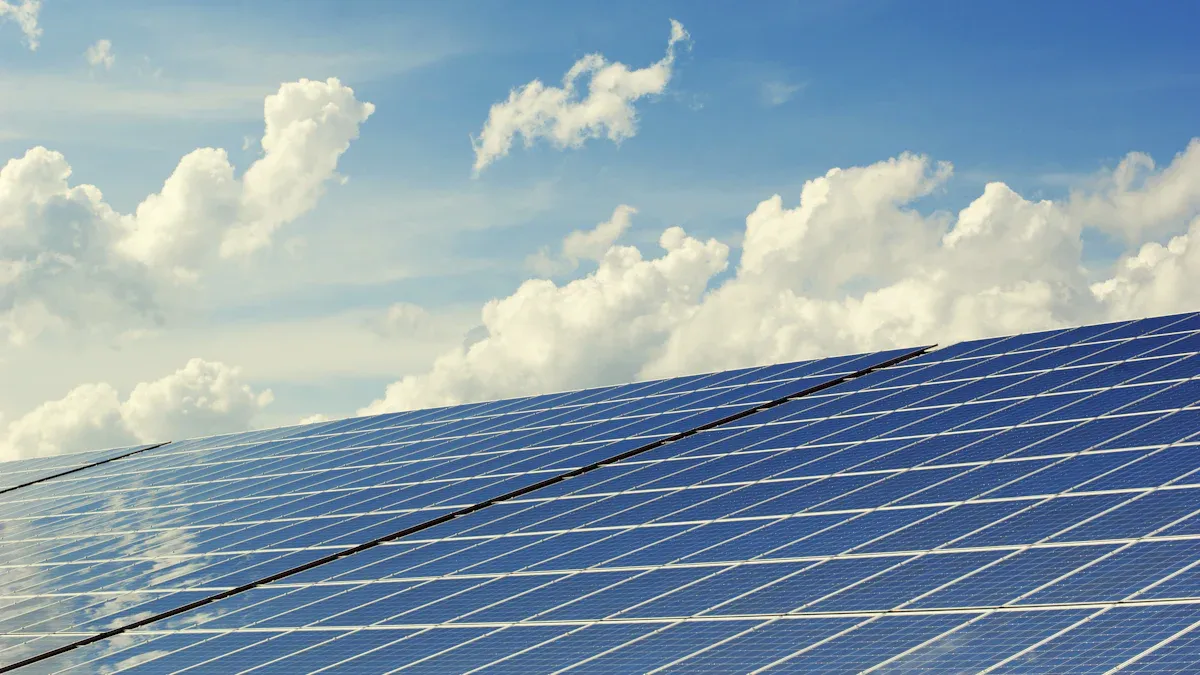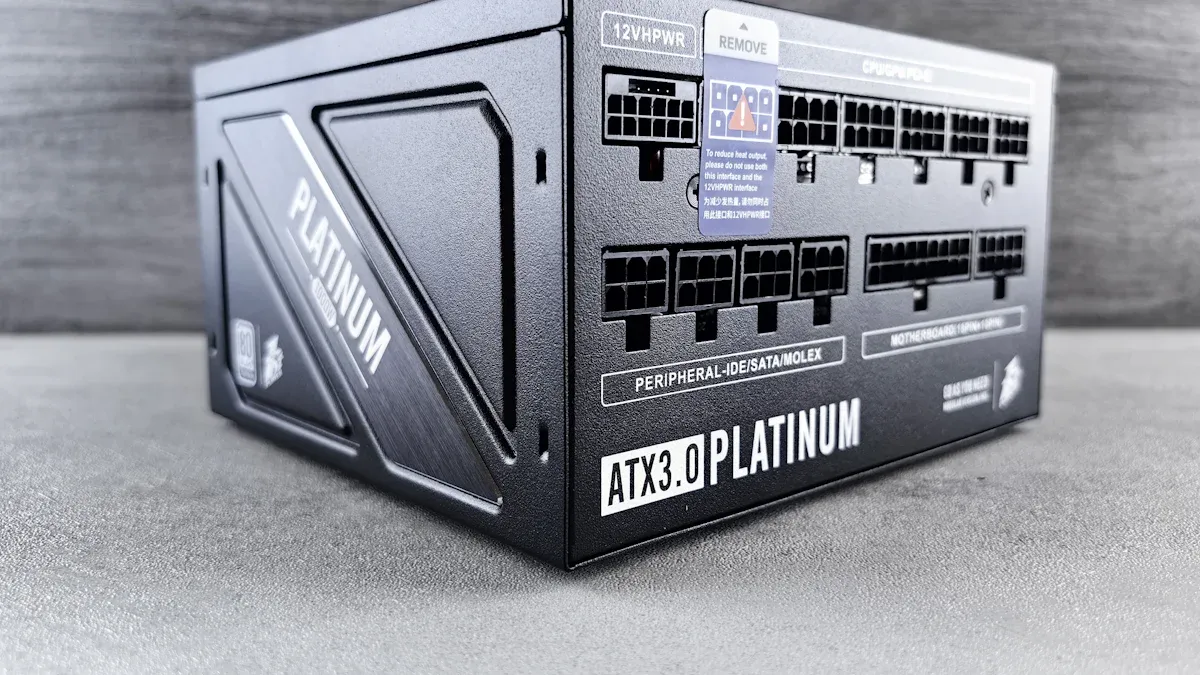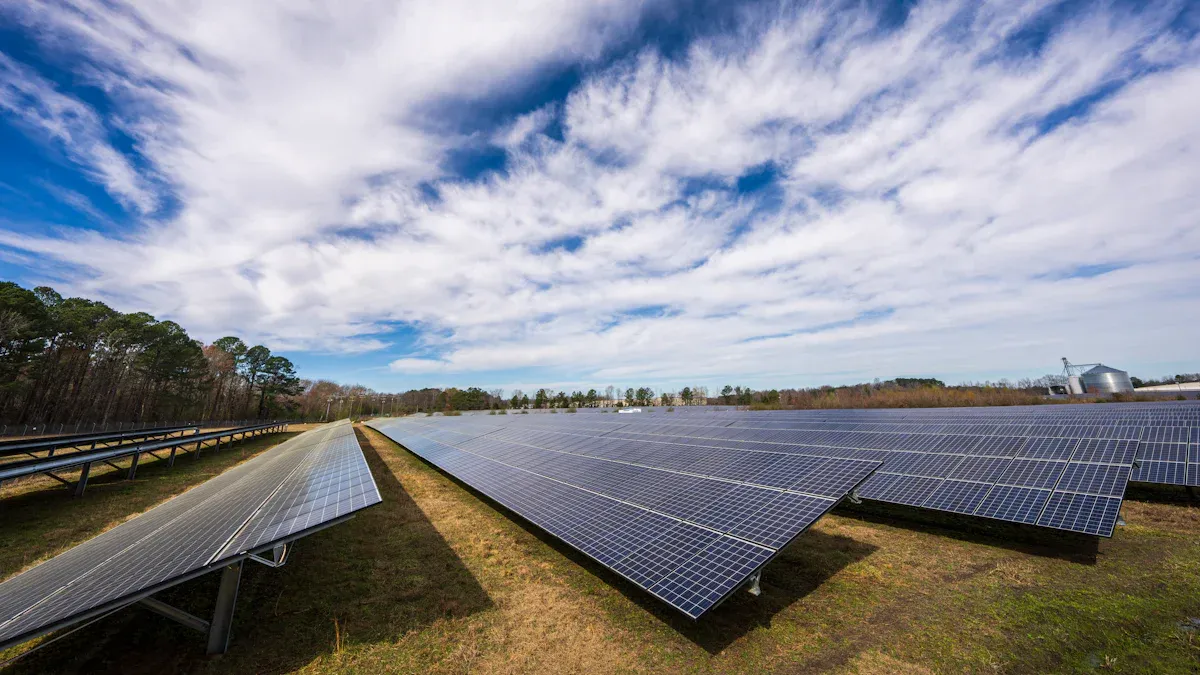Emerging Technologies Shaping Industrial Power Supplies

Industrial power supplies are key to keeping industries running smoothly. They help ensure work is done without interruptions. In 2023, their market value was USD 8.99 billion. By 2033, it is expected to grow to USD 15.11 billion. This shows a rising need for dependable power systems. But industries face problems like saving energy, being eco-friendly, and staying reliable. By 2025, new technologies like heat pumps using renewable energy will help. These can cut costs and support a cleaner environment. Governments are also offering rewards, like U.S. tax credits, to use better energy systems. These changes are shaping how industries make and use power by 2025.
Key Takeaways
Industrial power supplies are important for smooth work in factories. The market may grow from $8.99 billion in 2023 to $15.11 billion by 2033.
New technologies like special semiconductors and AI make power systems more efficient and reliable.
Using renewable energy can cut harmful gas emissions and save money for industries.
Better energy storage helps keep power steady and supports cleaner energy use.
Industries need to follow new rules and use new tech to stay competitive and meet green goals.
Current Problems in Industrial Power Supplies
Industrial power supplies face problems that make meeting demands harder. These problems include saving energy, being eco-friendly, and staying reliable. Fixing these issues is key for industries to adapt and meet green goals.
Saving Energy with Better Generators
Saving energy is very important to cut costs and waste. But there are some big challenges:
Not enough data on energy use and pollution makes planning hard.
Industries worldwide don’t share the same data rules, making comparisons tricky.
Limited info on energy sources makes switching fuels harder.
These problems show why we need new ideas, like better power tools and eco-friendly generators. The need for efficient and green generators is growing, pushing for better technology.
Going Green and Cutting Pollution
Industries are working to cut pollution and go green. New technology helps a lot with this change:
AI and green energy tools lower pollution and help energy changes.
Research shows better tech makes production cleaner and less polluting. For example, a study in China proved this.
Another study found that a small boost in green tech leads to more green energy use.
These studies show why adding green energy and smart tech to power systems is important. Using eco-friendly generators helps fight climate change and supports long-term green goals.
Reliable Power Tools for Industry
Reliability is crucial for industrial power supplies to avoid costly downtime. Power tools must handle problems like supply chain delays, old tech, and rising material costs. Reports highlight key issues:
Problem | What It Means |
|---|---|
Rising material costs | Makes products cost more for users. |
Tougher rules | Following rules adds costs and needs more research. |
Old technology | Fast changes mean products can quickly become outdated. |
Supply chain delays | Global issues slow deliveries and hurt inventory plans. |
Switching to green energy | Uncertainty as industries rethink power needs and use less old solutions. |
To solve these problems, industries need strong power tools and smart plans. This ensures smooth work and meets the rising need for better power systems.
Technological Advancements Transforming Industrial Power Supplies

Wide-Bandgap Semiconductors (GaN and SiC) in Power Electronics
Wide-bandgap semiconductors, like GaN and SiC, are changing power electronics. These materials work better than older silicon parts. They handle higher voltages, faster speeds, and hotter temperatures. This makes them great for industrial use. They also save energy, making systems more efficient.
New developments show big improvements in many areas. For example, SiC inverters in electric cars cut energy waste and help batteries last longer. GaN chargers make charging faster and reduce heat on batteries. In renewable energy grids, SiC and GaN converters keep energy steady and prevent voltage problems. These technologies show how they can save energy and help the environment.
These materials also solve heat problems. AI cooling systems help SiC and GaN parts last longer. This makes them reliable in tough industrial settings. As the industry grows, these advancements will shape the future of power electronics.
Artificial Intelligence and Edge Computing in Power Systems
AI and edge computing are improving industrial power systems. They process data quickly and make decisions on the spot. This reduces delays and makes systems work better. AI helps manage energy, predict problems, and improve reliability.
AI has been used in energy for years, but now it’s smarter. It helps control microgrids and predicts renewable energy production. For example, AI can guess how much solar energy will be made based on the weather. This helps use energy more efficiently.
By 2050, electricity will make up over half of energy use. This shows how important AI is for clean energy solutions. Edge computing helps by managing energy locally. Together, these tools make power systems stronger and more efficient.
Renewable Energy Integration for More Efficient and Sustainable Generators
Adding renewable energy is key to cleaner power. Solar and wind energy are now part of industrial power supplies. This reduces the need for fossil fuels and makes energy production better.
New solar panels and other tech make renewable energy cheaper and easier to use. Industries can now use generators that combine solar and wind power. These systems provide steady energy, even when the weather changes.
Studies show renewable energy can cut greenhouse gas emissions by 40% by 2040. Upgrading factories with renewable systems can lower emissions by 10–20% and save fuel costs. This proves renewable energy is vital for sustainability.
Backup modules, like TDK-Lambda’s DRM40, make systems more reliable. If one generator stops, another takes over to avoid downtime. These innovations show how renewable energy is making industrial power greener and more dependable.
Advanced Energy Storage Solutions for Industrial Applications
Energy storage systems are changing how industries manage power. They provide steady and efficient energy, helping industries avoid interruptions. These systems are important for industries that depend on generators. Advanced storage solutions bring many benefits like saving money, lasting longer, and working better.
Modern storage systems focus on key performance areas. Studies compare these systems to find their strengths and weaknesses. The table below explains these performance areas:
Performance Area | What It Means |
|---|---|
Heat Management | Checks how well systems handle heat in different situations. |
Energy Efficiency | Shows how much energy is used without waste. |
Strength Over Time | Tests how systems handle wear and tear during use. |
Lifespan | Measures how long systems work before they lose performance. |
Cost vs. Performance | Looks at the balance between cost and how well systems work. |
Risk of Wear | Studies how likely systems are to break down over time. |
Economic Benefits | Considers if systems are worth the cost and can be reused. |
Heat Effects | Examines how heat changes during repeated use. |
Long-Term Use | Studies how systems perform over a long time and ways to improve them. |
These areas show why choosing the right storage system is important. Systems with good heat management and durability can handle tough industrial needs. Efficiency and lifespan are also key because they affect costs and sustainability.
Adding renewable energy makes storage systems even better. Combining solar or wind power with advanced storage reduces the need for fossil fuels. This cuts pollution and keeps power steady when renewable energy changes.
New battery technology has made storage systems more reliable and affordable. Lithium-ion batteries store a lot of energy and last a long time, making them great for industries. Flow batteries are another option, storing large amounts of energy for longer periods. These improvements help industries switch to cleaner energy.
Backup energy systems are also crucial. They keep things running during power outages or equipment problems. For example, modular systems like TDK-Lambda’s DRM40 switch smoothly between main and backup power, ensuring reliability.
As industries use more renewable energy and advanced storage, the focus will be on improving performance and cutting costs. Research on heat effects and wear risks will help systems last longer. By using these technologies, industries can meet green goals and stay efficient.
Challenges and Opportunities in Adopting New Technologies
Cost and Scalability of Emerging Power Electronics
Using new power electronics has both problems and benefits. Advanced tools like wide-bandgap semiconductors cost a lot at first. This high price can stop industries from upgrading. But these tools save energy and last longer, helping in the long run. For example, using silicon carbide (SiC) parts in generators lowers energy use and makes machines last longer.
Scaling up these technologies is also hard. Many industries can’t use them widely because of supply chain issues. Factories don’t make enough parts to meet demand. Data centers, which will use 6% of U.S. electricity by 2026, show why scaling is urgent. Cleaner energy solutions are needed to handle bigger energy loads without losing performance.
Even with these problems, there are chances to improve. Watching how industries work and checking costs can help. For example, studying input and output can show where to save money. This helps industries find better ways to meet their energy goals.
Regulatory and Compliance Considerations for Industrial Power Supplies
New rules affect how industries use new power tools. By 2024, $174 billion will be spent on electric systems. About 42% of this money will go to improving power lines and grids. These updates aim to meet stricter rules and make systems better.
But there are problems, like waiting longer for transformers. Big transformers now take up to 210 weeks to arrive. Bad weather, costing $53 billion from January to August 2024, makes things worse. These issues raise power prices, which hit 13.09 cents per kWh in August 2024, up 2.7% from last year.
Still, following these rules can help industries. Companies that follow rules can get rewards and avoid fines. This lowers risks and makes systems more reliable.
Integration of Technological Advancements with Legacy Systems
Mixing new tools with old systems is tough. Old systems slow progress, and 70% of companies find it hard to upgrade. For 57% of tech leaders, old systems are the biggest problem. These issues cost industries up to $5 million each year.
But good plans can bring big rewards. One large retailer boosted sales by 40% after upgrading. They also cut transaction times by 50%. A car company saved 30% on production costs and sped up delivery by 25% with better systems.
Industries need smart plans to fix these problems. Using data and advanced tools can make work smoother. This helps industries switch to modern systems without trouble.
Future Outlook for Power Generators and Industrial Power Supplies

Trends in Programmable DC Power Supplies
Programmable DC power supplies are becoming more useful for industries. They are flexible and precise, making them great for many tasks. By 2033, their market is expected to grow from USD 1.2 billion in 2024 to USD 2.1 billion. This means they will grow by 7.5% each year from 2026 to 2033. Industries like car-making and chip-making are using them more.
New designs for single-output, dual-output, and multiple-output supplies are helping this growth. These designs meet different needs and work better. The table below shows how these types are expected to grow:
Type | Growth Predictions | Market Trends |
|---|---|---|
Single-Output Type | Yearly Growth Predictions | Market Attractiveness Analysis |
Dual-Output Type | Yearly Growth Predictions | Market Attractiveness Analysis |
Multiple-Output Type | Yearly Growth Predictions | Market Attractiveness Analysis |
Application | Yearly Growth Predictions | Market Attractiveness Analysis |
Region | Yearly Growth Predictions | Market Attractiveness Analysis |
The need for clean energy and better power tools is speeding up this trend. Programmable DC power supplies help industries save energy and work more efficiently.
The Role of Microgrids and Distributed Energy Resources
Microgrids and distributed energy resources (DERs) are changing how power is made and shared. These systems make energy more reliable by spreading out where it comes from. In the U.S., power outages have gone up by 64% in the last 10 years. Microgrids help by using renewable energy and advanced storage systems.
Electric cars also benefit from DERs. The number of electric cars in the U.S. will grow eight times bigger in five years. This means more need for local energy solutions. Data centers, which use 8% of the world’s electricity, also rely on microgrids. By 2030, data centers will use 3,200 terawatt hours of energy. DERs will help them keep running smoothly.
Anticipated Innovations in Power Electronics and Energy Systems
New ideas in power electronics and energy systems are shaping the future. AI tools are improving how heat is managed, making systems work better. Hybrid cooling methods, which mix active and passive techniques, are being used in space and airplane industries. These methods handle the high energy needs of electric planes and space missions.
Eco-friendly cooling is also a focus. Renewable energy and green materials are now used to cool systems. Data centers are switching to higher voltage power and new cooling methods like immersion cooling. These changes make systems more efficient and reliable.
Other exciting trends include faster charging stations that use advanced semiconductors. These stations charge batteries quickly. Green hydrogen systems are also growing, offering cleaner energy options for industries. These innovations aim to make power systems better, greener, and more efficient.
New technologies are changing how industrial power supplies work. They solve big problems like saving energy, being eco-friendly, and staying reliable. Tools like special semiconductors, smart AI systems, and green energy are making a difference. Exciting trends include better ways to store energy and using hydrogen as clean fuel.
The table below shows the main ideas behind these changes:
Main Ideas | What They Mean |
|---|---|
World Events | Changes in global supply chains for power systems. |
Energy Storage | New ways to save and use energy better. |
Electric Cars | How electric cars are changing energy needs. |
Nuclear Energy | New ideas and progress in nuclear power. |
Hydrogen | Using hydrogen as a cleaner energy choice. |
In the future, industries need to use these ideas to meet energy needs and protect the planet.
FAQ
What are the benefits of using wide-bandgap semiconductors in industrial power supplies?
Wide-bandgap semiconductors save energy and handle high voltages well. They create less heat, making systems last longer. These materials also improve renewable energy systems and electric cars. They help industries move toward cleaner energy solutions.
How does artificial intelligence improve power systems?
AI helps manage energy by predicting needs and spotting problems. It makes power systems work better and supports green energy use. AI also makes quick decisions, keeping power reliable and eco-friendly.
Why is renewable energy integration important for industries?
Renewable energy cuts the use of fossil fuels and pollution. It provides cleaner energy and helps industries save money. When paired with better storage, it makes energy more reliable and sustainable.
What role do microgrids play in industrial power systems?
Microgrids make energy more reliable by spreading out power sources. They use renewable energy and storage systems to reduce grid reliance. This setup lowers downtime and meets growing energy needs for electric cars and data centers.
How do advanced energy storage solutions benefit industries?
Advanced storage systems keep power steady, even during outages. They save energy, cut costs, and work well with renewable energy. These systems help industries switch to cleaner and greener energy options.
See Also
Key Aspects of Telecom Power Supply Features You Should Know
Tips for Guaranteeing Reliable Power Supply in Telecom Cabinets
A Guide to Global Standards for Communication Power Supplies
CALL US DIRECTLY
86-13752765943
3A-8, SHUIWAN 1979 SQUARE (PHASE II), NO.111, TAIZI ROAD,SHUIWAN COMMUNITY, ZHAOSHANG STREET, NANSHAN DISTRICT, SHENZHEN, GUANGDONG, CHINA

